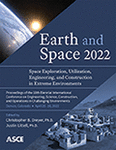Practical Space Resource Utilization at the Hundred Megatonne Scale: Enabling a Planetary Sunshade to Reverse Global Warming
Publication: Earth and Space 2022
ABSTRACT
Climate change is the defining issue of our time. Decarbonizing Earth's economy and removing existing carbon from the atmosphere are mandatory steps for addressing climate change, but may not occur quickly enough to avoid catastrophic global warming. Space-based solar radiation management is one technique to address global warming by deflecting a small percentage of incoming solar energy before it enters Earth's ecosphere. The concept of a planetary sunshade is a physical, thin-film structure of about one million square kilometers, placed at Sun-Earth Lagrange 1, to mitigate or even reverse global warming. If the sunshade is made from space resources, it could provide a powerful objective for developing a space resources economy built on megascale construction. The planetary sunshade could require hundreds of megatonnes of material to build; this scale of space resource utilization has only barely been considered. In August of 2021, the Planetary Sunshade Foundation, in conjunction with the Colorado School of Mines, held a workshop to begin development of a space resource utilization plan with an emphasis on the scale needed to construct the sunshade. The workshop had 25 attendees, representing civil space agencies, industry, academia, and researchers from six countries. Working groups focused on resource extraction and processing and logistics for both lunar and asteroidal resources. These groups discussed the current state of knowledge, knowledge gaps, and future work required for extraction and processing techniques and logistics architectures. The purpose of this paper is to describe the key findings and conclusions of that workshop.
Get full access to this article
View all available purchase options and get full access to this chapter.
REFERENCES
Agosto, W.N. (1984) Electrostatic Separation and Sizing of Ilmenite in Lunar Soil Simulants and Samples. Lunar and Planetary Science XV, pp 1–2. https://ui.adsabs.harvard.edu/abs/1984LPI….15….1A
Brophy, J. R., Friedman, L., & Culick, F. (2012). Asteroid retrieval feasibility. IEEE Aerospace Conference Proceedings, April, 1–51.
Environmental Protection Agency (2022). Impacts of Climate Change. https://www.epa.gov/climatechange-science/impacts-climate-change
Fix, S. (2021) Feasibility Study of a Sunshade in the Vicinity of the Sun Earth L1 Lagrange Point. IRS-21-S-006. Institute of Space Systems, University of Stuttgart. https://www.planetarysunshade.org/publications
Heiken, G. H., Vaniman, D. T., & French, B. M. (1991). Lunar Sourcebook. Cambridge University Press, 58(12), 778.
IPCC, 2021: Summary for Policymakers. In: Climate Change 2021: The Physical Science Basis. Contribution of Working Group I to the Sixth Assessment Report of the Intergovernmental Panel on Climate Change [Masson-Delmotte, V., P. Zhai, A. Pirani, S.L. Connors, C. Péan, S. Berger, N. Caud, Y. Chen, L. Goldfarb, M.I. Gomis, M. Huang, K. Leitzell, E. Lonnoy, J.B.R. Matthews, T.K. Maycock, T. Waterfield, O. Yelekçi, R. Yu, and B. Zhou (eds.)]. Cambridge University Press. In Press.
Jehle, A., Scott, E., & Centers, R. (2020). A planetary sunshade built from space resources. Accelerating Space Commerce, Exploration, and New Discovery Conference, ASCEND 2020.
Kornuta, D., Abbud-Madrid, A., Atkinson, J., Barr, J., Barnhard, G., Bienhoff, D., … & Zhu, G. (2019). Commercial lunar propellant architecture: A collaborative study of lunar propellant production. Reach, 13, 100026.
Maheswaran, T. (2021). Analysis of Logistical Construction Aspects of a Sunshade Concept in the Vicinity of the Sun Earth L1 Lagrange Point. IRS-21-S-017. Institute of Space Systems, University of Stuttgart. https://www.planetarysunshade.org/publications
McInnes, C. R. (1999). Solar Sailing. In Springer-Verlag Berlin Heidelberg GmbH. Springer London.
McInnes, C.R. (2002) Minimum mass solar shield for terrestrial climate control. Journal of the British Interplanetary Society, 55, pp. 307–311.
Pettit, D. (2012). The Tyranny of the Rocket Equation. https://www.nasa.gov/mission_pages/station/expeditions/expedition30/tryanny.html
Rasera, J. N., Cilliers, J. J., Lamamy, J. A., & Hadler, K. (2020). The beneficiation of lunar regolith for space resource utilisation: A review. Planetary and Space Science, 186(February), 104879.
Sánchez, J. P., McInnes, C. R., & Marchis, F. (2015). Optimal sunshade configurations for space-based geoengineering near the Sun-Earth L1 point. PLoS ONE, 10(8), 1–25.
United Nations (2021). Climate Change. https://www.un.org/en/global-issues/climate-change
Weber, R. C. (2014). Interior of the Moon. In Encyclopedia of the Solar System (Third Edition). Elsevier.
Information & Authors
Information
Published In
History
Published online: Jan 5, 2023
Authors
Metrics & Citations
Metrics
Citations
Download citation
If you have the appropriate software installed, you can download article citation data to the citation manager of your choice. Simply select your manager software from the list below and click Download.
